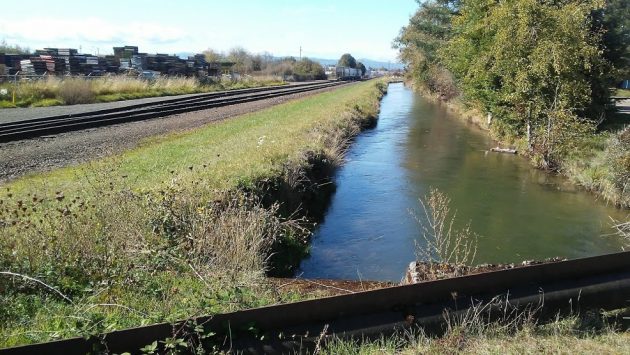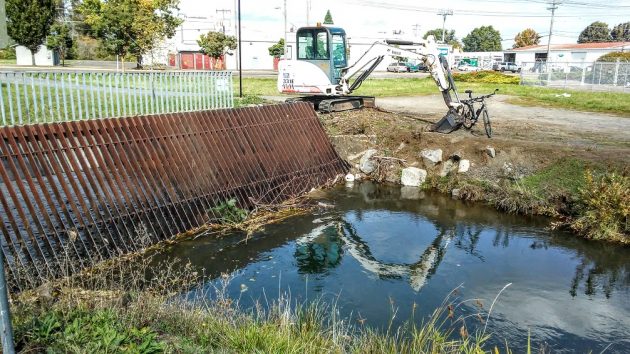
This open stretch of the Santiam Canal west of Marion Street looks inviting, but it’s not.
Readers of this site may be aware of my fascination with the Albany-Santiam Canal. The other day I wondered whether in some segments this waterway might be suitable for a little boating, and upon reflection the answer is no, it’s not.
South of 34th Avenue and both east and west of Marion Street, the canal seems relatively open and unobstructed by bushes and trees on the banks. So you’d think one might be able to drop a canoe or kayak in there and paddle up and down.
Probably not, though. For one thing, it’s apparently not allowed. There’s a no-trespassing sign south of 34th.
For another, there’s the current. You could go downstream all right, and the culvert under Marion Street loooks big enough to let you through — unless there are some utility pipes in there that you can’t see from the bank.
But going upstream would be a struggle, and you wouldn’t make much progress, if any. The current last week was flowing at just about normal walking speed, which is said to be between 3 and 4 miles an hour. A couple of people in a canoe can go about 3 miles an hour, so going upstream would be a lost cause no matter how furious their paddling pace.
This should be no surprise. Remember that according to its history, the canal was built to take grain down to the Willamette. That worked until they tried to pull the barges back upstream. The current proved too much.
If even teams of draft horses were not strong enough, mere human paddlers are bound to fail. Good thing too. Otherwise people would try it and the city might feel compelled to fence more segments of the canal the way it has long been fenced downtown. (hh)

A culvert takes the canal underneath Marion Street.

The sign discourages access to the canal south of 34th Avenue.

This grate near 34th stops all kinds of stuff floating downstream, including a soccer ball.

Why would anyone want to paddle down a narrow ditch that eventually provides drinking
water to Albany?
Looks like HH is scratching a mental itch.
Good history angle as well
Who wouldn’t want an additional, clean, local, floating opportunity? An old fuddy duddy?
No need to go back upstream, float on tubes and have a shuttle vehicle. Looks like a navigable water way to me, which makes it legal for me to float. We’ll try it out this summer. Thanks for the info!
Good luck!
Perhaps the City could transport the newly refurbished duck over from Waverly Lake to promote diverse community participation in making the canal integral to the inner urban core, serving both the immediate populations along with, in an inclusive manner, all other segments of the social fabric of Albany.
I find the ditch to be a dangerous anachronism. This is 2020, not 1880, and it appalled me that this open waterway passes through agricultural fields (hello, farm chemicals and animal poop), under a freeway (hello, auto pollution and potential for diesel tanker…or worse…to end up in the ditch), through neighborhoods and under city streets (hello, vandals chucking all kinds of crap…literally…into the stream just for the sheer heck of it), let alone an attractive nuisance. Sure, it’s cute but for a city of 50,000 people I think it is a risky, outdated way to deliver our drinking water. This water should be in a pipe not a ditch.
RB
Admirable objections. Without disagreement, what’ the price tolerance?
I see no difference in water sanitation or safety when it’s in the canal OR in the Santiam River before it hits the canal. I’d wager that once the water passes through Foster Reservoir and the City of Sweet Home, it is little changed by it trip in the canal.
Thanks Chad, I was about to make the same comment. I might also add that the canal also by-passes the Lebanon sewage disposal plant.
An interesting read. One wonders about the losses incurred by the original investors who financed the canal waterway as a means of cargo transportation. Why didn’t they first spend money on a proper feasibility study? By consulting with a surveyor the question of upstream navigation may have been answered before breaking ground on the project. Discovering the problem after the project was completed must have been a huge disappointment along with the financial loss. Was this a public or private venture?
At least Albany was provided with a municipal water source other than the Willamette.